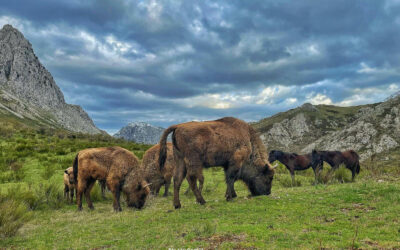Photo credit: Image by Virvoreanu Laurentiu from Pixabay.
Benefits and Trade-Offs of Environmental DNA (eDNA) in Wilderness Character Monitoring
BY JESSE ENGEBRETSON and COURTNEY E. LARSON
Science + Research
October 2024 | Volume 30, Number 2

The Wilderness Act of 1964 states that federally designated wilderness areas in the United States are to be “protected and managed so as to preserve its natural conditions.” Despite longstanding and important debates about the slippery – and some would argue, unnuanced (Cole and Yung 2012) – implications of “natural,” the federal land management agencies in the US responsible for the stewardship of the National Wilderness Preservation System are mandated to preserve it. An essential aspect of stewarding wilderness is monitoring, as it provides a foundational element of empirically informed management decisions. Keeping It Wild 2, the seminal interagency guide for developing wilderness character monitoring protocols, defines the natural quality of wilderness character as “ecological systems [being] substantially free from the effects of modern civilization” (Landres et al. 2015, p. 11) and suggests several indicators for which managers and on-the-ground personnel identify measures that are unique to – and representative of – the wildernesses they steward. It can be difficult to monitor the natural quality of wilderness character given the remote nature of wilderness areas coupled with the high sensitivity of sampling needed to help preserve it. As such, it is essential for land management agencies to use the best available scientific information in developing and improving measures of the natural quality of wilderness character, which could be achieved by adopting novel biophysical monitoring technologies, even if there are some trade-offs associated with new approaches.
eDNA in a Wilderness Context
Genetic material is constantly being shed by all living organisms in an environment. During the past decades, researchers have begun to collect samples of – and analyze – this dizzying array and abundance of environmental material (Kelly et al. 2023). This environmental DNA (eDNA) can be collected, filtered, and isolated to potentially represent all species present in that environment, and analyzed to determine specific species or taxonomic group presence or abundance. For example, a land manager can determine the presence of difficult-to-find invasive species or endangered species when populations are too small to detect using conventional methods such as trapping or visual surveys (Coble et al. 2019). Importantly for resource-strapped land managers, eDNA monitoring is relatively inexpensive, efficient, and reliable (and becoming all the more so as technology advances) (Kelly et al. 2014). DNA is isolated from an environmental sample (e.g., filtered water or air), and there are several ways of analyzing this DNA. Methods of analyzing eDNA currently include single-species assays using PCR (e.g., quantitative or qPCR) to determine the presence or abundance of a particular species of interest (Beng and Corlett 2020). A slightly different approach, multispecies amplicon sequencing (e.g., metabarcoding), allows determining what species’ DNA are present, making it possible to assess biodiversity (Deiner et al. 2017). Such an approach may lead to more comprehensive, representative, and efficiently collected data than traditional biological monitoring. Technical processes and considerations for various contexts are discussed extensively in other publications (e.g., Morisette et al. 2021).
In a wilderness context, it is essential to note that eDNA monitoring is noninvasive, nondestructive, does not constitute a trammeling action, and no permanent or semipermanent installations are needed for data collection. Managers simply need reliable technicians, rangers, volunteers, or other personnel to extract small samples (e.g., from water, soil, or air filters if there are existing air monitoring installations) from wildernesses. Several methods have been developed and validated to collect samples from remote areas using minimal supplies in easy-to-carry packaging. For example, Carim et al. (2016) uses a lithium battery powered peristaltic pump to filter on site in streams and preserves filters in desiccant. Portable backpack eDNA samplers are also available and include self-desiccating filters (Thomas et al., 2018). Working in partnership with universities (e.g., CAL eDNA), federal agencies (e.g., the Environmental Protection Agency), federal research stations (e.g., National Genomics Center for Wildlife and Fish Conservation), or private contractors to analyze the samples would ameliorate the need for training and access to a lab for analyses.
Challenges and Trade-Offs
Despite the evident benefits of eDNA monitoring, there may be some trade-offs especially salient to the wilderness management community. For instance, there is an eDNA learning curve in implementation. Although eDNA has met the technological criteria as a well-developed technology, each management concern and wilderness area may require a different sampling and analysis strategy, which may need multiple sampling seasons to validate and improve as methods are rapidly evolving (Goldberg et al. 2016). For example, a 2017 implementation of a qPCR assay for invasive Dreissena mussels in Lake Superior did not detect any mussels (Trebitz et al., 2019), yet in a 2019 survey, with filtering more water and improving qPCR primers the eDNA methods were more sensitive than conventional methods (Larson et al., 2022). This requires patience and trustworthy partnerships between eDNA scientists and wilderness managers (Stein et al. 2023). Also, the resource expenditures may still be high based on the research context, despite their potential reduction long term (Fu et al. 2019). There are also concerns with resulting datasets and their interpretation that require guidance and collaboration with eDNA expert partners. Further, it is important to note that differences in both sample collection and laboratory analysis protocols can lead to different results, which further emphasizes the need to understand the tool, or have agencies work closely with an eDNA expert, when interpreting results. Lastly, while eDNA can convey the presence of an organism, scientists are unable to ascertain salient information about the health of a population, such as the number of organisms present, their reproductive success, or their lifespan and quality of life. Given these considerations, eDNA may not be the right tool for every wilderness area, but in some, such critical monitoring datasets could meaningfully inform the stewardship of wilderness.
These tradeoffs have been widely recognized in the literature (Burian et al., 2021; Darling et al. 2021); however, there are additional considerations relevant to application of eDNA methods in wilderness monitoring settings specifically which have not yet been fully appreciated. Taking a sample from the field and sending it to a lab abstracts away the materiality of wilderness. As such, what was once an in-place and purposeful observation of the more-than-human world becomes an S-shaped curve on a graph through a computer screen when DNA is detected. Contrasting this, conventional taxonomic and morphological monitoring approaches rely on biological technicians spending a significant amount of time in the field and expertise in identification (Ficetola, Thuiller, and Miaud 2007). Although many locations within individual wildernesses will still likely require multiday hitches to collect eDNA samples, these technicians may not have the same opportunities as those in the past to develop taxonomic identification and observation skills because of the shift to eDNA sampling. Additionally, because of potentially less time in the field, technicians may not develop as deep of a sense of place or have crucial time for personal reflection, which may play a significant role in developing as future scientists and managers.
Future Potential for Monitoring Wilderness Character
Although these fears may be realized, eDNA monitoring in wilderness may also impact technicians in novel and powerful ways. For instance, technicians may develop a more spatially extensive sense of place, if, for instance, they are allowed to collect more data across multiple wildernesses within a season. Or, technicians may be profoundly affected by seeing the findings of a computer program’s examination of hundreds of thousands of chemical bases of DNA and understand what our human senses are inherently unable to experience: that the signs of life are in nearly every material thing on the planet and that metabarcoding a small sample collected from a wilderness area can vividly convey that complexity in a comprehensible way. Additionally, a diversity of field sampling protocols including eDNA may make field work more equitable to a variety of physical abilities, creating a more diverse workforce to better steward wilderness areas. Further, in many remote wilderness areas, scientists and managers do not know what species are present because these places are too difficult to access with traditional equipment. As such, an eDNA sample might be the only information that can be easily obtained. In such a situation, data from such a sample could potentially show managers all the species present in an area, not just one species of interest at a particular time. As new management challenges arise, this sample can be archived for analysis of additional species in the future. It can also inform managers where the effort for more intensive data collection and field work will be useful because an organism is likely present. Thus, despite the potential trade-offs, the use of eDNA monitoring in wilderness may yield myriad benefits and help us better understand the state of the natural quality of wilderness character in individual wildernesses as well as help managers make empirically informed decisions based on the best available scientific information available (Darling 2019). Such science-based management is essential for wilderness stewardship in the 21st century.
NOTE: The views expressed in this article are those of the author(s) and do not necessarily represent the views or policies of the United States Environmental Protection Agency
JESSE ENGEBRETSON is a social scientist in the Office of Research and Development Great Lakes Toxicology and Ecology Division in the United States Environmental Protection Agency; email: Engebretson.jesse@epa.gov.
COURTNEY E. LARSON is a biologist in the Office of Research and Development Great Lakes Toxicology and Ecology Division in the United States Environmental Protection Agency; email: larson.courtney@epa.gov.
References
Burian, A., Q. Mauvisseau, M. Bulling, S. Domisch, S. Qian, & M. Sweet. 2021. Improving the reliability of eDNA data interpretation. Molecular Ecology Resources, 21(5): 1422-1433. https://doi.org/10.1111/1755-0998.13367.
Carim, K. J., K. S. McKelvey, M. K. Young, T. M. Wilcox, and M. K. Schwartz. 2016. A Protocol for Collecting Environmental DNA Samples from Streams (pp. 1–18). US Department of Agriculture, Forest Service, Rocky Mountain Research Station.
Coble, A. A., C. A. Flinders, J. A. Homyack, B. E. Penaluna, R. C. Cronn, and K. Weitemier. 2019. eDNA as a tool for identifying freshwater species in sustainable forestry: A critical review and potential future applications. Science of the Total Environment 649: 1157–1170. https:// doi.org/10.1016/j.scitotenv.2018.08.370.
Cole, D. N., and L. Yung, eds. 2012. Beyond Naturalness: Rethinking Park and Wilderness Stewardship in an Era of Rapid Change. Washington, DC: Island Press.
Darling, J. A. 2019. How to learn to stop worrying and love environmental DNA monitoring. Aquatic Ecosystem Health & Management 22(4): 440–451. https://doi.org/10.10 80/14634988.2019.1682912.
Darling, J. A., C. L. Jerde, & A. J. Sepulveda. 2021. What do you mean by false positive? Environmental DNA, 3(5): 879-883.
Deiner, K., H. M. Bik, E. Mächler, M. Seymour, A. Lacoursière‐Roussel, F.Altermatt, . . . and L. Bernatchez. 2017. Environmental DNA metabarcoding: Transforming how we survey animal and plant communities. Molecular Ecology 26(21): 5872–5895. https://doi. org/10.1111/mec.14350.
Ficetola, G. F., W. Thuiller, and C. Miaud. 2007. Prediction and validation of the potential global distribution of a problematic alien invasive species – the American bullfrog. Diversity and Distributions 13(4): 476–485. https://doi.org/10.1111/j.1472-4642.2007.00377.x.
Fu, M., L. G. Hemery, and N. K. Sather. 2021. Cost Efficiency of Environmental DNA as Compared to Conventional Methods for Biodiversity Monitoring Purposes at Marine Energy Sites (No. PNNL-32310). Richland, WA: Pacific Northwest National Laboratory. https://doi.org/10.2172/1984522.
Goldberg, C. S., C. R. Turner, K. Deiner, K. E. Klymus, P. F. Thomsen, M. A. Murphy, . . . and P. Taberlet. 2016. Critical considerations for the application of environmental DNA methods to detect aquatic species. Methods in Ecology and Evolution 7(11): 1299– 1307. https://doi.org/10.1111/2041-210X.12595.
Kelly, R. P., D. M. Lodge, K. N. Lee, S. Theroux, A. J. Sepulveda, C. A. Scholin, . . . and S. B. Weisberg. 2023. Toward a national eDNA strategy for the United States. Environmental DNA: 1–10. https://doi.org/10.1002/edn3.432.
Kelly, R. P., J. A. Port, K. M. Yamahara, R. G. Martone, N. Lowell, P. F. Thomsen, . . . and L. B. Crowder. 2014. Harnessing DNA to improve environmental management. Science 344(6191): 1455–1456. http://doi.org/10.1126/science.1251156.
Landres, P. B., C. Barns, J. G. Dennis, T. Devine, P. Geissler, C. S. McCasland, and R. Swain. 2015. Keeping It Wild 2: An Updated Interagency Strategy to Monitor Trends in Wilderness Character Across the National Wilderness Preservation System. US Department of Agriculture, Forest Service, Rocky Mountain Research Station.
Morisette, J., S. Burgiel, K. Brantley, W. M. Daniel, J. Darling, J. Davis, . . . and T. Wilcox. 2021. Strategic considerations for invasive species managers in the utilization of environmental DNA (eDNA): Steps for incorporating this powerful surveillance tool. Management of Biological Invasions: International Journal of Applied Research on Biological Invasions 12(3): 747. http://doi.org/0.3391/mbi.2021.12.3.15.
Stein, E. D., C. L. Jerde, E. A. Allan, A. J. Sepulveda, C. L. Abbott, M. R. Baerwald, . . . and P. M. Thielen. 2023. Critical considerations for communicating environmental DNA science. Environmental DNA: 1–12. https://doi.org/10.1002/edn3.472.
Sternhagen, E. C., M. A. Davis, E. R. Larson, S. E. Pearce, S. M. Ecrement, A. D. Katz, & J. H. Sperry. 2024. Comparing cost, effort, and performance of environmental DNA sampling and trapping for detecting an elusive freshwater turtle. Environmental DNA, 6(2): e525.
Thomas, A. C., J. Howard, P. L. Nguyen, T. A. Seimon, & C. A. Goldberg. 2018. eDNA Sampler: A fully integrated environmental DNA sampling system. Methods in Ecology and Evolution 9(6): 1379-1385. https://doi.org/10.1111/2041-210X.12994
Trebitz, A. S., C. L. Hatzenbuhler, J. C. Hoffman, C. S. Meredith, G. S., Peterson, E. Pilgrim, J. T. Barge, A. M. Cotter, & M. J. Wick. 2019. Dreissena veligers in western Lake Superior – Inference from new low-density detection. Journal of Great Lakes Research 45(3): 691-699. https://doi.org/10.1016/j.jglr.2019.03.013
Read Next
Missing the Forest for the Algorithm
What is the value of wilderness? Well, what you have just completed reading is the “value of wilderness” as described by ChatGPT 3.5.
Rewilding Prerequisites: An Ecocentric Approach
Rewilding is increasingly gaining momentum as a conservation practice in Europe.
Trusting Tech and Wilderness in the 21st Century
A Response to Keeling’s The Trouble with Virtual Wilderness



